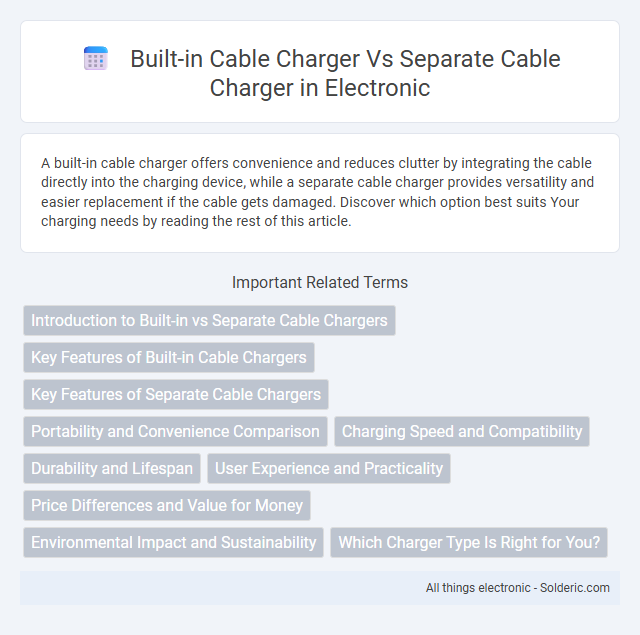A built-in cable charger offers convenience and reduces clutter by integrating the cable directly into the charging device, while a separate cable charger provides versatility and easier replacement if the cable gets damaged. Discover which option best suits Your charging needs by reading the rest of this article.
Comparison Table
| Feature | Built-in Cable Charger | Separate Cable Charger |
|---|---|---|
| Portability | Less portable, cable fixed | Highly portable, cable detachable |
| Replacement | Charger must be replaced entirely | Cable or charger replaced independently |
| Convenience | Integrated design, fewer parts | Flexible use with multiple cables |
| Durability | Wear damages entire unit | Damaged cables replaced separately |
| Cost | Usually cheaper upfront | Potentially higher initial cost |
| Compatibility | Limited to fixed cable type | Works with various cable types |
| Charging Speed | Depends on integrated cable specs | Optimized with choice of cable |
Introduction to Built-in vs Separate Cable Chargers
Built-in cable chargers integrate the charging cable directly into the device or adapter, offering convenience and reducing the risk of losing cables. Separate cable chargers consist of standalone chargers paired with detachable cables, providing flexibility to swap cables for different devices or replace damaged ones easily. Both designs cater to different user preferences, balancing portability, versatility, and durability in charging solutions.
Key Features of Built-in Cable Chargers
Built-in cable chargers offer enhanced convenience with an integrated charging cable that reduces the risk of forgetting or losing cables, streamlining your charging experience. These chargers often feature compact, all-in-one designs that support fast charging protocols such as USB Power Delivery or Qualcomm Quick Charge, ensuring efficient power transfer. Their durability is improved by reducing cable wear and tear common with detachable cables, providing a reliable, travel-friendly charging solution for your devices.
Key Features of Separate Cable Chargers
Separate cable chargers offer greater versatility through interchangeable cables compatible with multiple devices, reducing the need for device-specific chargers. They enable easy replacement of worn or damaged cables without discarding the entire charger, improving cost-effectiveness and sustainability. Enhanced portability is another benefit, as users can carry only the cables needed for different devices, minimizing bulk and clutter.
Portability and Convenience Comparison
Built-in cable chargers offer enhanced portability by integrating the cable directly into the charger, reducing the need to carry multiple items and minimizing clutter. Separate cable chargers provide flexibility in cable length and compatibility with various devices, catering to users who prefer customizable setups. The choice depends on individual priorities between compactness and adaptability for everyday charging needs.
Charging Speed and Compatibility
Built-in cable chargers often provide optimized charging speeds tailored to the specific device model, ensuring efficient power delivery and faster charging times. Separate cable chargers offer greater compatibility across multiple devices, supporting various connectors like USB-C, Lightning, and Micro-USB, but may result in slightly slower charging speeds due to generic power output. Choosing between the two depends on prioritizing either optimized charging speed or versatile device compatibility.
Durability and Lifespan
Built-in cable chargers often have limited durability due to fixed cable wear and increased risk of internal damage, reducing overall lifespan compared to separate cable chargers. Separate cable chargers allow easy replacement of damaged cables, extending device usability and minimizing maintenance costs. High-quality detachable cables paired with robust chargers typically result in longer-lasting charging solutions.
User Experience and Practicality
Built-in cable chargers offer enhanced user experience by reducing clutter and eliminating the need to carry extra accessories, making charging more convenient for on-the-go use. Separate cable chargers provide greater flexibility and compatibility across multiple devices, allowing users to replace or upgrade cables independently without replacing the entire charger. Practicality depends on user preferences; built-in cables suit minimalists seeking simplicity, while separate cable systems cater to those prioritizing versatility and easy maintenance.
Price Differences and Value for Money
Built-in cable chargers often come at a higher initial price due to their integrated design, reducing the need for additional accessories and minimizing cable loss or damage. Separate cable chargers tend to be more affordable upfront, offering flexibility to replace only the cable or charger if damaged, which can save money over time. Evaluating value for money depends on usage habits; built-in chargers provide convenience and durability, while separate chargers offer cost-effective versatility.
Environmental Impact and Sustainability
Built-in cable chargers reduce electronic waste by minimizing the number of separate accessories needed, directly lowering resource consumption and landfill contributions. Separate cable chargers offer flexibility for replacement or upgrades, potentially extending the lifespan of your devices and reducing the need for full charger replacements. Choosing between the two options influences your environmental footprint, as durability and recyclability play key roles in sustainable tech usage.
Which Charger Type Is Right for You?
Built-in cable chargers offer convenience and reduced clutter by integrating the charging cable directly into the charger, making them ideal for travel and minimalistic setups. Separate cable chargers provide greater flexibility, allowing users to replace or upgrade cables independently, which benefits those with multiple devices or specific cable needs. Choosing the right charger depends on your priority between portability and adaptability for diverse charging scenarios.
Built-in cable charger vs separate cable charger Infographic

 solderic.com
solderic.com